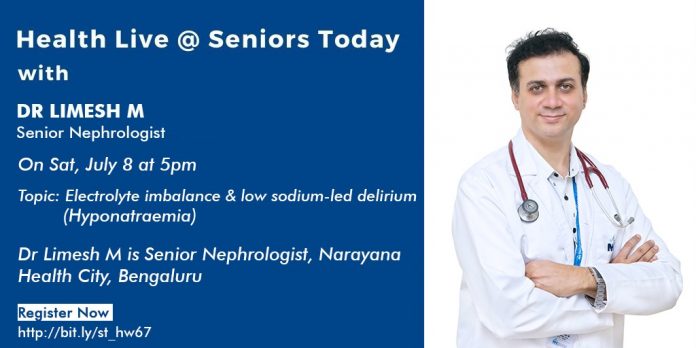Reading Time: 3 minutes
On 08 Jul, 2023, Seniors Today hosted their weekly Health Live webinar with Dr Limesh M, Senior Nephrologist at Narayana Health City, Bengaluru. He spoke on and answered questions about Electrolyte imbalance & low sodium-led delirium (Hyponatraemia)
Dr Limesh M is Consultant Nephrologist & Transplant Physician at Mazumdar Shaw Medical Center, Narayana Health City, Bengaluru. He has completed an MD (General Medicine) from JSS Medical Centre, Mysore and DNB (Nephrology) from NBE Hospital, Chennai He complete his Fellowship in Nephrology from University of Ottawa, Ottawa Hospital, Canada. He has been Associate Professor of Nephrology at the St John’s Medical College, Bengaluru.
Hyponatraemia is defined as low sodium levels in our body. Sodium is nothing but the salts that we consume in various forms in our day to day life. And it plays a critical role in our daily normal physiological functioning of the body including- memory, actions, mobility, mood, etc.
Similarly, high levels of sodium in our body is medically called hypernatraemia.
Electrolyte imbalances have detrimental effects on our body.
Kidneys play a major role in the absorption and reabsorption of salts (sodium). This is called Renal Sodium Handling.
Daily sodium consumption is between 3-4 gms in the US diet, however in the Indian diet it is near 10-12 gms/ day.
In the kidneys, 1.5 kgs of sodium is reabsorbed. Which means that the kidneys have an efficiency of 99.6% of sodium reabsorption.
Most of the sodium is reabsorbed in the S1 segment of the proximal segment of the nephron.
Whenever there is excess sodium in the body, the kidney excretes the excess sodium from the body.
And when the sodium in the body is low, the kidney tries to reabsorb the sodium.
Certain control mechanisms are also available in the loop of Henle- a part of the kidney- in the form of sympathetic activity, cyclic amp mediated vasopressin- procalcitonin inhibitors, increased flow to the tubules.
The fine tuning of sodium is done in the distal nephrons.
The nephron helps in the concentration and production of urine.
60% of sodium is absorbed in the proximal tubule
30% of sodium is absorbed in the tick ascending loop of Henle
Remaining in the dial convoluted tubules
And less than 1% in the collecting tubules
Sodium is a major, extracellular cation. Anything less than 135 mg/dL is defined as hyponatraemia.
This has a prevalence of 30- 35% in a hospitalised patient and 2-3% in other patients.
This low levels of sodium in the blood lead to increased morbidity and mortality in the hospitalised patients.
Types of hyponatraemia:
- Symptomatic
- Asymptomatic: no manifestation of symptoms of hyponatraemia
Symptomatic patients may present with the following symptoms:
- Drowsiness
- Irritability
- Lethargy
- Myalgia
- Subtle neuro cognitive symptoms
Hyponatraemia can also be:
- Acute- manifestation of symptoms/ low levels of sodium in the patient is less than 48 hours
- Chronic- manifestation of symptoms/ low levels of sodium in the patient is more than 48 hours. This can also be associated with osteoporosis leading to increased incidence and risk of fractures.
Based on the severity it can be classified as:
- Mild
- Moderate
- Severe- these patients can also land up in a coma. These patients can also have cerebral oedema- collection/ accumulation of water in the brain. This causes raised intracranial tension leading the patient to throw fits/ seizures. And can also ultimately lead to irreversible brain damage
Low sodium levels is an indicator of low plasma osmolality.
Low sodium levels in the blood lead to the water entering into the brain from the blood. The brain starts to accommodate this excess water in the brain in the form of losing the sodium, chloride and potassium further leading to lower levels of sodium. This is called chronic adaptation. Overcorrection of the sodium levels at this point can lead to dangerous and deleterious effects of over correction in the form of osmotic demyelination.
Approach:
These patients are approached based on the onset- acute or chronic and the severity of hyponatraemia.
In these patients we not only check their sodium levels but also the plasma osmolality. In patients with normal plasma osmalality- it is called pseudo hyponatraemia. Other causes are looked into.
In true hyponatraemia, we try to determine whether it is
- Euvlolemic hyponatramia- SIDH (Syndrome of Inappropriate Diuretic Hormone), hypothroidism
- Hypovolemic hyponatramia- extra renal loss such as in the case of loose stools, excessive vomoting, burns > 30%
- Hypervolemic hyponatramia- patients of heart failure, liver failure, renal failure, nephrotic syndromes
Treatment:
- Replenishment of lost sodium levels
- Slow correction of sodium is the approach used- over days to weeks and not overnight (unlike correction of potassium) to avoid CNS complication
- Increased intake of salt in diet
- NaCl infusions








